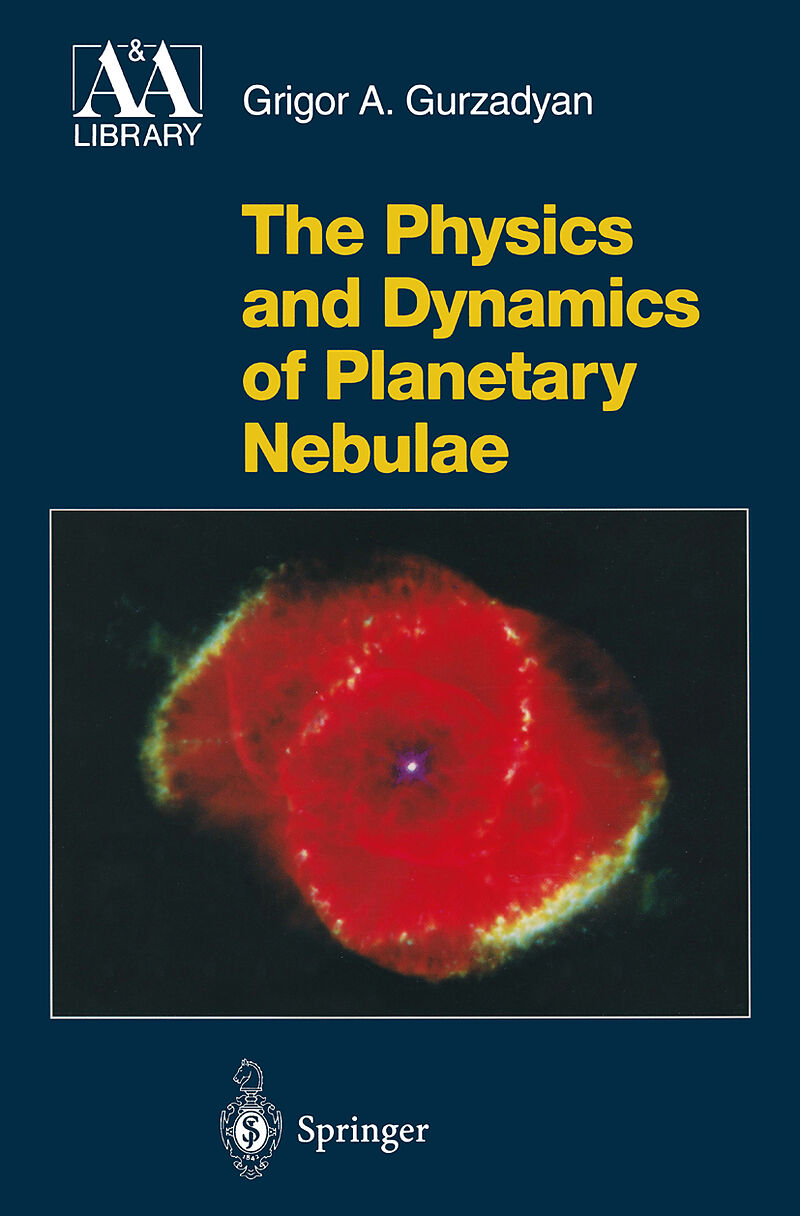The Physics and Dynamics of Planetary Nebulae
Einband:
Fester Einband
EAN:
9783540609650
Untertitel:
Astronomy and Astrophysics Library
Autor:
Grigor A. Gurzadyan
Herausgeber:
Springer Berlin Heidelberg
Auflage:
1997
Anzahl Seiten:
536
Erscheinungsdatum:
17.04.1997
ISBN:
3540609652
Die Physik und Dynamik planetarer Nebel steht im Mittelpunkt dieser Monographie. Ausführlich wird die Entstehung und Evolution planetarer Nebel behandelt und durch einen Katalog der planetaren Nebel veranschaulicht.
Planetary nebulae are the classic subject of astrophysics. The physical pro cesses occurring in this highly ionized gaseous medium, the formation of emis sion lines in clearly specified conditions, the continuous emission extending from the far ultraviolet up to infrared and radio frequencies, the generation of exotic forms of radiation predicted by atomic physics, along with methods for deciphering the observed spectra and detecting physical and kinematic parameters of the radiating medium, etc. - all these problems form the solid foundations of the physical theory of gaseous nebulae. They are an essential part of the arsenal of powerful tools and concepts without which one cannot imagine understanding and interpreting the enormous diversity of processes taking place in the Universe - in gaseous envelopes surrounding the stars of various classes, from cool dwarfs and flare stars up to hot supergiants, as well as in stellar chromospheres and coronae, in atmospheres of unstable and anomalous stars, in circumstellar clouds and gaseous shells born in nova and supernova explosions, in diffuse nebulae and the interstellar medium, in interacting binary systems, in galaxies with emission lines, in quasars, etc. The last thirty years have seen a turning-point in our knowledge concern ing the very nature of planetary nebulae (PNs). The radio emission of PNs was discovered after it was predicted theoretically. On the other hand, the powerful infrared emission discovered both in the continuum and in emission lines was never expected.
Klappentext
Planetary nebulae are the classic subject of astrophysics. The physical pro cesses occurring in this highly ionized gaseous medium, the formation of emis sion lines in clearly specified conditions, the continuous emission extending from the far ultraviolet up to infrared and radio frequencies, the generation of exotic forms of radiation predicted by atomic physics, along with methods for deciphering the observed spectra and detecting physical and kinematic parameters of the radiating medium, etc. - all these problems form the solid foundations of the physical theory of gaseous nebulae. They are an essential part of the arsenal of powerful tools and concepts without which one cannot imagine understanding and interpreting the enormous diversity of processes taking place in the Universe - in gaseous envelopes surrounding the stars of various classes, from cool dwarfs and flare stars up to hot supergiants, as well as in stellar chromospheres and coronae, in atmospheres of unstable and anomalous stars, in circumstellar clouds and gaseous shells born in nova and supernova explosions, in diffuse nebulae and the interstellar medium, in interacting binary systems, in galaxies with emission lines, in quasars, etc. The last thirty years have seen a turning-point in our knowledge concern ing the very nature of planetary nebulae (PNs). The radio emission of PNs was discovered after it was predicted theoretically. On the other hand, the powerful infrared emission discovered both in the continuum and in emission lines was never expected.
Inhalt
1. Global Concepts.- 2. The Origin of Emission Lines.- 3. Emission Lines of Hydrogen and Helium.- 4. Ionization Equilibrium of Planetary Nebulae.- 5. Temperature of Nebular Nuclei.- 6. Electron Temperature. Electron Concentration.- 7. Planetary Nebulae in the Ultraviolet.- 8. Pseudoresonance Lines.- 9. Continuous Radiation of Nebulae. Two-Photon Emission.- 10. Infrared Radiation of Planetary Nebulae.- 11. Radiative Equilibrium: Classical Theory.- 12. Distances and Dimensions of Planetary Nebulae.- 13. Double-Envelope Nebulae.- 14. Radio Emission of Planetary Nebulae.- 15. Anomalous Planetary Nebulae.- 16. Dynamics of Planetary Nebulae.- 17. Magnetic Fields in Planetary Nebulae.- 18. Origin and Evolution of Planetary Nebulae.- Plates.- References.- Books, Catalogues, Proceedings.- Early Period, up to 1969.- Later Period, 19701989.- The Most-Recent Period, 19901996.- Object Index.

Leider konnten wir für diesen Artikel keine Preise ermitteln ...
billigbuch.ch sucht jetzt für Sie die besten Angebote ...
Die aktuellen Verkaufspreise von 6 Onlineshops werden in Realtime abgefragt.
Sie können das gewünschte Produkt anschliessend direkt beim Anbieter Ihrer Wahl bestellen.
Loading...
Die aktuellen Verkaufspreise von 6 Onlineshops werden in Realtime abgefragt.
Sie können das gewünschte Produkt anschliessend direkt beim Anbieter Ihrer Wahl bestellen.
| # | Onlineshop | Preis CHF | Versand CHF | Total CHF | ||
|---|---|---|---|---|---|---|
| 1 | Seller | 0.00 | 0.00 | 0.00 |
